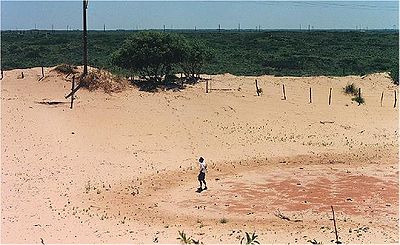
Blowout (geology)
Encyclopedia

Depression (geology)
A depression in geology is a landform sunken or depressed below the surrounding area. Depressions may be formed by various mechanisms.Structural or tectonic related:...
s in a sand dune
Dune
In physical geography, a dune is a hill of sand built by wind. Dunes occur in different forms and sizes, formed by interaction with the wind. Most kinds of dunes are longer on the windward side where the sand is pushed up the dune and have a shorter "slip face" in the lee of the wind...
ecosystem (psammosere
Psammosere
A psammosere is a seral community, an ecological succession that began life on newly exposed coastal sand. Most common psammoseres are sand dune systems....
) caused by the removal of sediments by wind
Wind
Wind is the flow of gases on a large scale. On Earth, wind consists of the bulk movement of air. In outer space, solar wind is the movement of gases or charged particles from the sun through space, while planetary wind is the outgassing of light chemical elements from a planet's atmosphere into space...
.
Blowouts occur in partially vegetated dune
Dune
In physical geography, a dune is a hill of sand built by wind. Dunes occur in different forms and sizes, formed by interaction with the wind. Most kinds of dunes are longer on the windward side where the sand is pushed up the dune and have a shorter "slip face" in the lee of the wind...
fields or sandhill
Sandhill
A sandhill is a type of ecological community or xeric wildfire-maintained ecosystem. It is not the same as a sand dune. It features very short fire return intervals, one to five years. Without fire, sandhills undergo ecological succession and become more oak dominated.Entisols are the typical...
s. A blowout forms when a patch of protective vegetation is lost, allowing strong winds to "blow out" sand and form a depression. Although they generally remain small, blowouts can expand to kilometers in size and up to around 70m in depth.
Causes of vegetation loss include extended droughts, fire (natural and anthropogenic) or, in extreme cases, trampling by humans, cattle, horses, etc. Fire is the most common cause, however. In time, succession will begin again as suitable seeds are blown in and pioneers become re-established.
Coastal sand dunes are found just inland from a beach, and are formed as the wind blows dry sand inland beyond the beach. It follows that this can only happen when there is an area of reasonably flat land inland from the beach. In time, this rather inhospitable surface will be colonised by pioneer species. These species (e.g. marram grass) will stabilise the dunes and prevent them moving any more. The process of plant succession
Ecological succession
Ecological succession, is the phenomenon or process by which a community progressively transforms itself until a stable community is formed. It is a fundamental concept in ecology, and refers to more or less predictable and orderly changes in the composition or structure of an ecological community...
will eventually see these dune
Dune
In physical geography, a dune is a hill of sand built by wind. Dunes occur in different forms and sizes, formed by interaction with the wind. Most kinds of dunes are longer on the windward side where the sand is pushed up the dune and have a shorter "slip face" in the lee of the wind...
s converted to woodland (depending on the climate) and a mature soil will have formed.
Blowouts provide an important habitat
Habitat (ecology)
A habitat is an ecological or environmental area that is inhabited by a particular species of animal, plant or other type of organism...
for flora and fauna.
See also
- Aeolian processes
- Blowout grassBlowout grassBlowout grass, Redfieldia flexuosa, is a grass that can be found on sand dunes. The plants grow in small clusters, protecting each other from the harsh desert conditions.-Range:...
- Médanos
- Sand dune ecologySand dune ecologySand dune ecology describes the biological and physico-chemical interactions that are a characteristic of sand dunes.Sand dunes provide a range of habitats for a range of unusual, interesting and characteristic plants that can cope with disturbed habitats...
- Sand Hills (Nebraska)Sand Hills (Nebraska)The Sand Hills, often written Sandhills, is a region of mixed-grass prairie on grass-stabilized sand dunes in north-central Nebraska, covering just over one quarter of the state...
- YardangYardangA yardang is a streamlined hill carved from bedrock or any consolidated or semiconsolidated material by the dual action of wind abrasion, dust and sand, and deflation. Yardangs become elongated features typically three or more times longer than wide, and when viewed from above, resemble the hull of...

